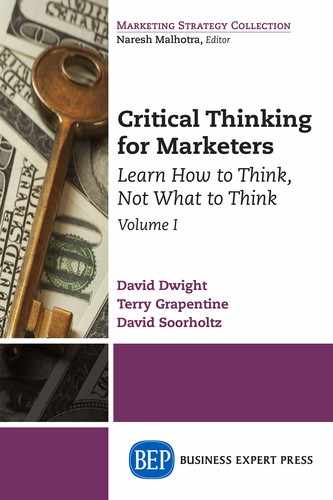Ability, critical thinking, 5–6
Accomplishment, appeal to, 57–60
Accuracy versus precision, 113
Ad Hoc Rescue, 47–49
Ad Hominem fallacy, 11, 26, 49–50
Affirming a disjunct fallacy, 32–33
Affirming the consequent fallacy, 10, 33–36
Against self-confidence fallacy, 51–53
Alleged certainty fallacy, 12–13, 53–55
Ambiguity fallacy, 11, 55–57
Argument, 8
Argument by Gibberish, 92–94
Authority, appeal to, 14, 60–62
Bad reasons fallacy, 36–38
Biased sample fallacy, 97–99
Causal oversimplification fallacy, 99–102
Central tendency, statistical measures of, 129–130
Cogent argument, 22
Common belief, appeal to, 62–65
Conclusion, 8
Conflict of interest, 102–104
Consequences, appeal to, 65–67
Counterfactual fallacy, 104–106
Deductive argument, 20–21
Desperation, appeal to, 67–68
Double-Jeopardy law, 84
E for effort, 106–108
Emotion, appeal to, 69–71
Extremes, appeal to, 71–73
Faith, appeal to, 74–76
Fallacy
dealing with, 12–13
description, 10
formal, 25–26
informal, 26–27
logical, 9–12
nature of, 10
False dilemma fallacy, 108–110
False precision fallacy, 110–113
Faulty comparison, 114–116
Fear, appeal to, 76–78
Formal fallacy, 25–26
Formal logical fallacies
affirming a disjunct, 32–33
affirming the consequent, 33–36
bad reasons, 36–38
illicit major, 38–40
illicit minor, 40–42
negating antecedent and consequent, 43–44
Generalization fallacy, 116–117
General rule fallacy, 159–161
Grapefruit diet strategy, 85
Guerrilla marketing strategy, 94
Guilt by association, 117–119
Harvard Business Review, 4
Hasty generalization fallacy, 120–122
Hypnotic bait and switch fallacy, 122–124
Illicit major fallacy, 38–40
Illicit minor fallacy, 40–42
Inductive argument, 20–21
Inflation of conflict, 124–126
Informal fallacy, 26–27
Informal logical fallacies
accomplishment, appeal to, 57–60
Ad Hoc Rescue, 47–49
alleged certainty, 53–55
ambiguity, 55–57
argument by Gibberish, 92–94
authority, appeal to, 60–62
biased sample, 97–99
causal oversimplification, 99–102
common belief, appeal to, 62–65
conflict of interest, 102–104
consequences, appeal to, 65–67
counterfactual fallacy, 104–106
desperation, appeal to, 67–68
E for effort, 106–108
emotion, appeal to, 69–71
example, 45–46
extremes, appeal to, 71–73
faith, appeal to, 74–76
false dilemma, 108–110
false precision, 110–113
faulty comparison, 114–116
fear, appeal to, 76–78
generalization, 116–117
general rule fallacy, 159–161
guilt by association, 117–119
hasty generalization, 120–122
hypnotic bait and switch, 122–124
inflation of conflict, 124–126
logical inconsistency, 126–128
ludic fallacy, 161–164
lying with statistics, 128–131
misleading vividness, 131–133
moderation, argument to, 95–97
moon, appeal to, 88–90
nirvana fallacy, 133–135
non sequitur fallacy, 137–138
No True Scotsman fallacy, 135–137
novelty, appeal to, 78–80
personal attack fallacy, 49–50
poisoning the well, 139–140
popularity, appeal to, 80–83
possibility, appeal to, 83–86
prejudicial language, 140–142
proof by intimidation, 142–144
Red Herring fallacy, 144–146
regression to the mean fallacy, 146–149
relative privation, 149–150
ridicule, appeal to, 86–88
scapegoating, 150–152
selective attention, 152–154
against self-confidence, 51–53
slippery slope, 154–157
special pleading, 157–159
Strawman fallacy, 164–167
tradition, appeal to, 90–92
Internet Encyclopedia of Philosophy, 10
Logical fallacies
description, 9–12
marketing theory and, 14–16
nature of, 25–27
Logical inconsistency fallacy, 126–128
Ludic fallacy, 161–164
Lying with statistics fallacy, 128–131
Marketing arguments
deductive argument, 20–21
inductive argument, 20–21
interpretations, 7–9
nature of, 19–23
reasons for, 22–23
valid argument, 20–21
Marketing strategies and tactics, formulating, 4–5
Marketing theory, 14–16
Mean, 129
Median, 129
Misleading vividness, 131–133
Mode, 130
Moderation, argument to, 95–97
Modus ponens, 26
Moon, appeal to, 88–90
Negating antecedent and consequent fallacy, 43–44
Nirvana fallacy, 133–135
Non sequitur fallacy, 31, 137–138
No True Scotsman fallacy, 135–137
Novelty, appeal to, 78–80
Optimization algorithm, 93
Personal attack fallacy, 49–50
Poisoning the well fallacy, 139–140
Popularity, appeal to, 11, 80–83
Possibility, appeal to, 83–86
Prejudicial language fallacy, 140–142
Premises, 8
Proof by intimidation fallacy, 142–144
4Ps, marketing mix, 5
Red Herring fallacy, 144–146
Regression to the mean fallacy, 146–149
Relative privation fallacy, 149–150
Ridicule, appeal to, 86–88
Scapegoating fallacy, 150–152
Selection effect, 84
Selective attention fallacy, 152–154
Slippery slope fallacy, 154–157
Special pleading fallacy, 157–159
Statement, 8
Statistical measures of central tendency, 129–130
Strawman fallacy, 164–167
Strong inductive argument, 21–22
Tradition, appeal to, 90–92
Valid argument, 20–21
Wall Street Journal, The, 4
